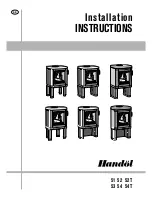
20
Problem
Solution
POOR DRAFT:
Extend chimney in length or have the chimney realigned to the proper size flue. Oversized chimneys normally have
poor drafts. Remember, the stoves’ draft depend solely on the natural draft of the chimney (See Draft Requirements on
Page 4
). If your stove is not drafting properly, your chimney is the problem. All stoves are thoroughly tested to ensure
proper draft with the correct size chimney flue.
EXCESSIVE DRAFT:
With better chimneys being more common, excessive draft can be an issue. Alleviate excessive draft by slowing the
burn rate of the stove once it has reached proper operating temperature (See Maximizing Your Stoves Overall Efficiency
on
Page 18
).
DIRTY GLASS:
1) Burn smaller, hotter fires and check to make sure you are not setting the draft down too far with the draft control.
2) Make sure your wood is well-seasoned and dry (not open to rain - see Creosote and Fuel sections on
Page 5
).
3) See Poor Draft section (above) and Cleaning Glass on
Page 16
.
SMOKES WHEN
1) If smoke is entering the room, check to make sure your baffle boards are properly installed
DOOR IS OPEN:
and that the baffle blankets are pushed back flush with the front of the baffle boards.
2) Check the chimney for blockage due to creosote (see Chimney and Creosote sections on
Pages 5 and 6
).
3) Check draft (See POOR DRAFT section above).
WOOD BURNS
1) The draft control must be closed further.
TOO FAST:
2) Add fuel at lower firebox temperatures.
3) Load wood side to side and reduce the flow of air under wood.
4) The door seal may need replacing, check for leakage.
5) See “Excessive Draft.”
POOR HEAT OUTPUT:
1) Check your wood. Wet, moist, unseasoned wood will not produce heat.
2) Your stove needs to be seasoned (moisture removed from the steel and brick). Continue to burn a fire. It normally
takes from one to three weeks of burning to season your stove (See Burn-In Period on
Page 5
).
3) See Excessive Draft section above.
PAINT GIVES OFF
Paint is tempering-in. Burn only moderately hot for the first few days until paint is fully cured.
ODOR (smoke):
Then burn a very hot fire to cure any paint that may not easily cure. Open windows or door to ventilate (See Burn-In
Period on
Page 5
).
TROUBLESHOOTING















































